The solutions to Bridges in Mathematics Grade 3 Student Book Answer Key Unit 5 Module 4 can help students to clear their doubts quickly.
Bridges in Mathematics Grade 3 Student Book Answer Key Unit 5 Module 4
Bridges in Mathematics Grade 3 Student Book Unit 5 Module 4 Session 1 Answer Key
Grid Paper
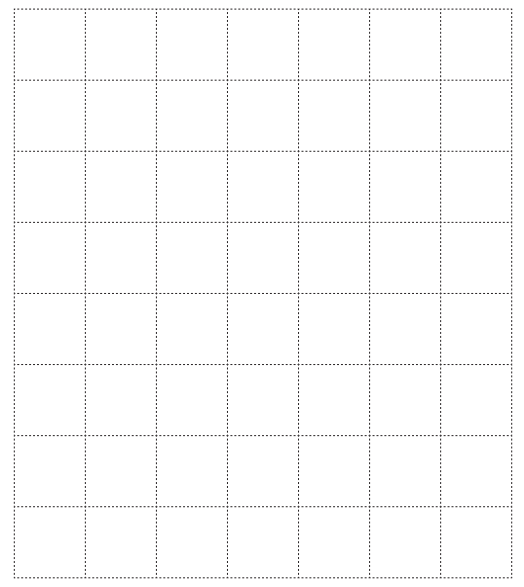
More Multiplication Arrays
Question 1.
Complete the multiplication facts.

Answer:
The multiplication facts:

Explanation:
Given Equations:
6 × 7 = 42.
3 × 8 = 24.
4 × 9 = 36.
9 × 9 = 81.
4 × 7 = 28.
3 × 9 = 37.
7 × 3 = 21.
8 × 2 = 16.
2 × 9 = 18.
6 × 8 = 48.
3 × 6 = 18.
5 × 9 = 45.
6 × 6 = 36.
9 × 7 = 63.
Question 2.
Use the array to show how you could solve each fact if you didn’t already know the answer.
ex:
6 × 9 = 54
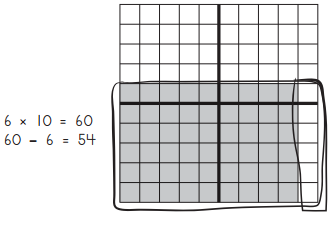
a. 7 × 8 = ___________
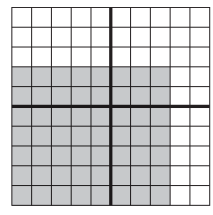
Answer:
7 × 8 = 56.
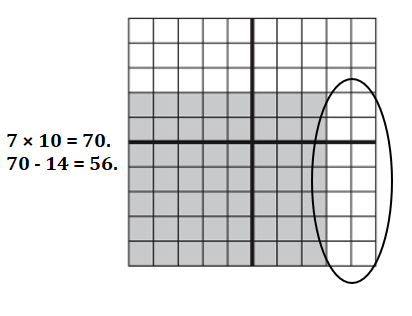
Explanation:
7 × 8 = ??
Mulitplication:
7 × 10 = 70.
70 – 14 = 56.
=> 7 × 8 = 56.
b. 7 × 7 = ____________
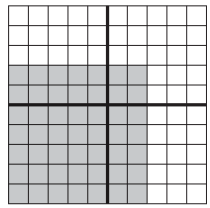
Answer:
7 × 7 = 49.
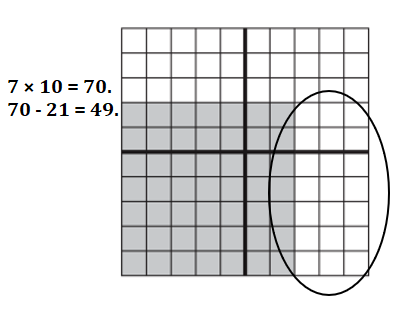
Explanation:
7 × 7 = ??
Mulitplication:
7 × 10 = 70.
70 – 21 = 49.
=> 7 × 7 = 49.
c. 8 × 4 = _____________
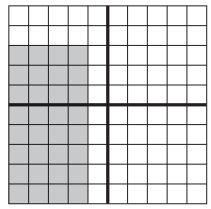
Answer:
8 × 4 = 32.
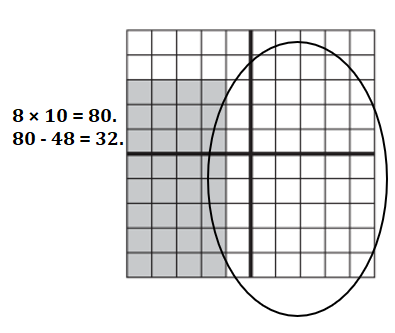
Explanation:
8 × 4 = ??
Mulitplication:
8 × 10 = 80.
80 – 48 = 32.
=> 8 × 4 = 32.
Bridges in Mathematics Grade 3 Student Book Unit 5 Module 4 Session 2 Answer Key
Finding Areas Large & Small
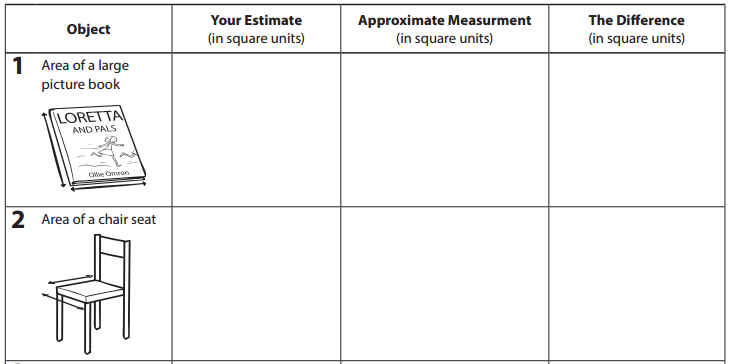
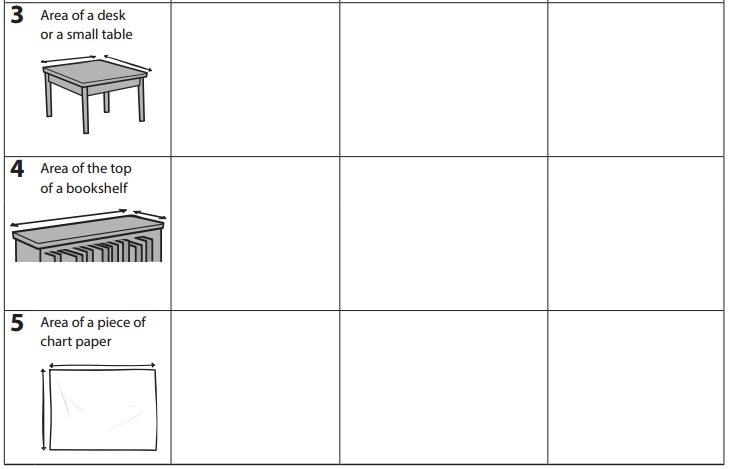
I noticed:
Answer:
I noticed:
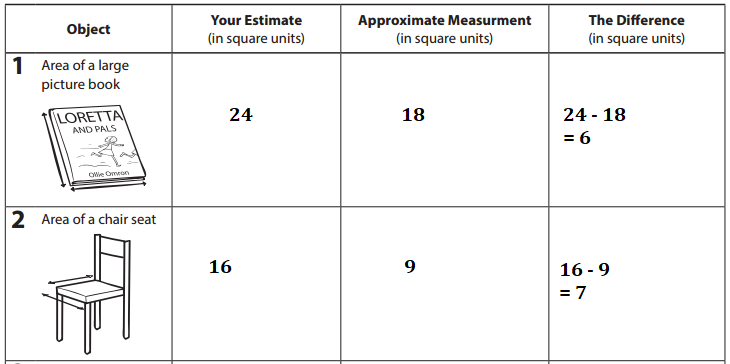
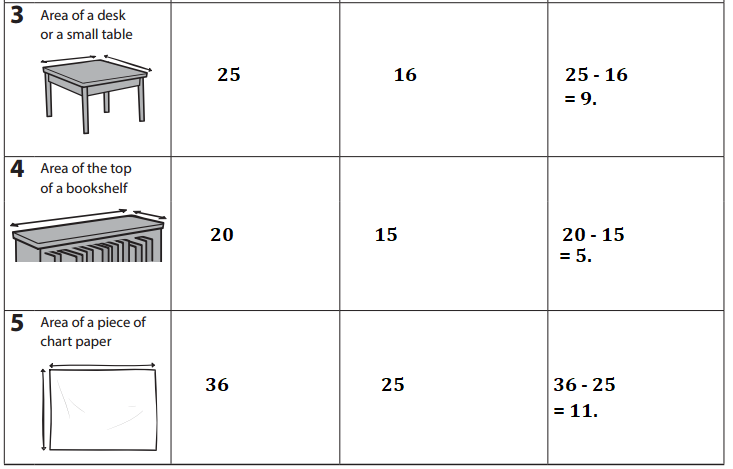
Explanation:
Estimation:
1. Area of a large picture book = 24 square cm.
2. Area of a chair set = 16 square cm.
3. Area of a desk or a small table = 25 square cm.
4. Area of the top of a bookshelf = 20 square cm.
5. Area of piece of chart paper = 36 square cm.
Approxiate measurement:
1. Area of a large picture book:
Large picture book is in an rectangle shape.
=> Area of a large picture book = Length × breadth
=> 6cm × 3cm
=> 18 square cm.
2. Area of a chair set:
Chair set is in square shape.
Area of a chair set = Side × Side
=> 3cm × 3cm
=> 9 Square cm.
3. Area of a desk or a small table:
Small table shape is a square.
=> Area of a desk or a small table = Side × Side
=> 4cm × 4cm
=> 16 Square cm.
4. Area of the top of a bookshelf:
Top of a bookshelf is in rectangle shape.
Area of the top of a bookshelf = Length × breadth
=> 5cm × 3cm
=> 15 square cm.
5. Area of piece of chart paper:
Piece of chart paper is in square shape.
Area of piece of chart paper = = Side × Side
=> 5cm × 5cm
=> 25 Square cm.
Question 6.
The rectangles below have already been marked with square units. Record the dimensions of each and then find the area. Write 2 different equations to show how you found the area of each.
ex:
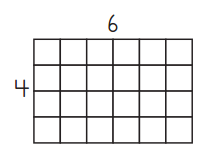
Area = 24 square units
Equations:
6 + 6 + 6 + 6 = 24
4 × 6 = 24
a.
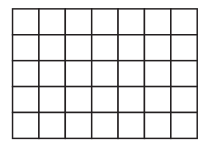
Area = ______________ square units
Equations:
Answer:
Area = 35 square units.
Explanation:
Length of the rectangle = 7 units.
Breadth of the rectangle = 5 units.
Area of the rectangle:
=> 7 + 7 + 7 + 7 + 7 = 35 square units.
=> Length of the rectangle × Breadth of the rectangle
= 7 × 5
= 35 square units.
b.

Area = ______________ square units
Equations:
Answer:
Area = 21 square units.
Explanation:
Length of the rectangle = 7 units.
Breadth of the rectangle = 3 units.
Area of the rectangle:
=> 7 + 7 + 7 = 21 square units.
=> Length of the rectangle × Breadth of the rectangle
= 7 × 3
= 21 square units.
c.

Area = ______________ square units
Equations:
Answer:
Area = 18 square units.
Explanation:
Length of the rectangle = 6 units.
Breadth of the rectangle = 3 units.
Area of the rectangle:
=> 6 + 6 + 6 = 18 square units.
=> Length of the rectangle × Breadth of the rectangle
= 6 × 3
= 18 square units.
Grid Paper
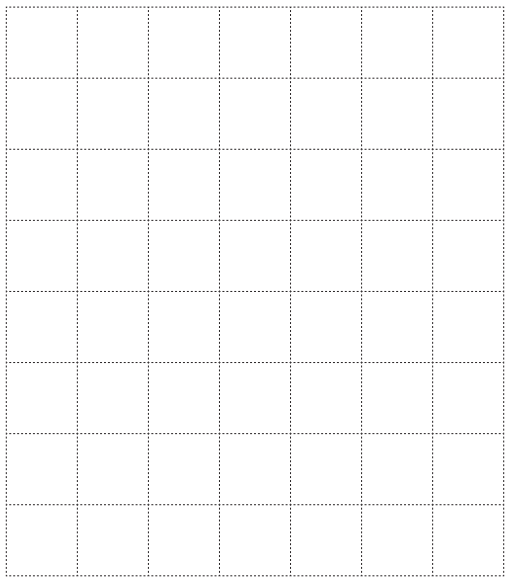
Finding More Areas
You’ll need a partner and some large square units made out of construction paper to do this sheet. Choose 5 different rectangular surfaces around the room to measure with the large square units. Be sure to estimate the area first.
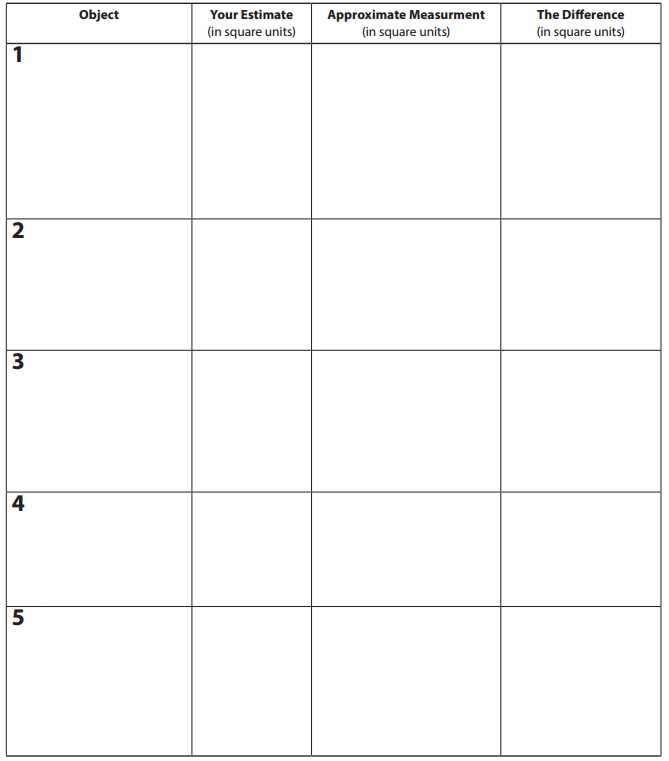
Answer:
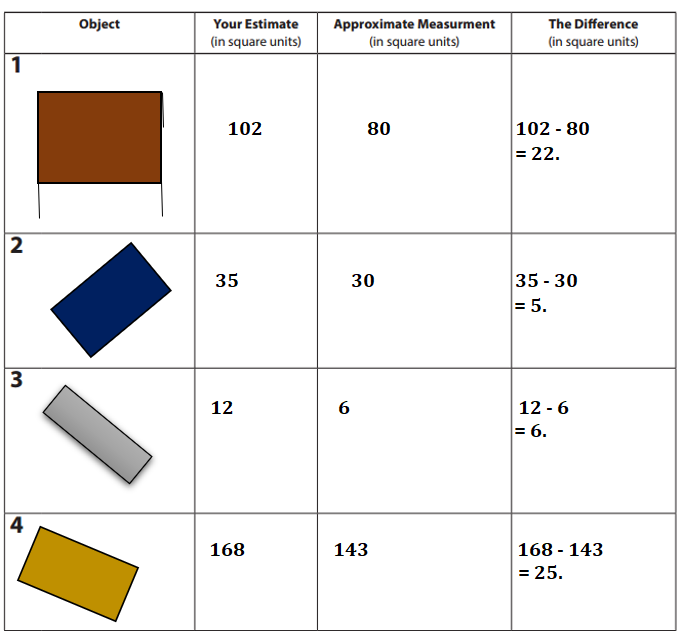

Explanation:
1. Area of the Dinning table =
Estimation: 102 square units.
Actual measurement: 16 × 5 = 80 square units.
Difference: 102 – 80 = 22 square units.
2. Area of the rectangle box =
Estimation: 35 square units.
Actual measurement: 6 × 5 = 30 square units.
Difference: 35 – 30 = 5 square units.
3. Area of pencil box =
Estimation: 12 square units.
Actual measurement: 3 × 2 = 6 square units.
Difference: 12 – 6 = 6 square units.
4. Area of table =
Estimation: 168 square units.
Actual measurement: 13 × 11 = 143 square units.
Difference: 168 – 143 = 25 square units.
5. Area of the television:
Estimation: 450 square units.
Actual measurement: 22 × 16 = 352 square units.
Difference: 450 – 352 = 98 square units.
Bridges in Mathematics Grade 3 Student Book Unit 5 Module 4 Session 3 Answer Key
Measuring My Math Journal
Question 1.
Estimate the area of the front cover of your math journal in square inches.
Estimate: _____________
Answer:
Estimate: Area of the front cover of your math journal = 120 square inches.
Explanation:
Length of the front cover of your math journal = 15 inches.
Breadth of the front cover of your math journal = 8 inches.
Area of the front cover of your math journal = Length of the front cover of your math journal × Breadth of the front cover of your math journal
= 15 × 8
= 120 square inches.
Question 2.
Using measurement tools from your classroom (ruler, tiles, grid paper, etc.), determine the area of the front cover of your math journal in square inches. Use words, labeled sketches, and numbers to explain how you got your answer.
Area of my math journal ______________.
Answer:
Area of the front cover of your math journal = 65 square inches.
Area of my math journal – 65 square inches.
Explanation:
Estimate: Area of the front cover of your math journal = 120 square inches.
Actual measurement:
Length of the front cover of your math journal = 13 inches.
Breadth of the front cover of your math journal = 5 inches.
Area of the front cover of your math journal = Length of the front cover of your math journal × Breadth of the front cover of your math journal
= 13 × 5
= 65 square inches.
Question 3.
CHALLENGE If you were to make a book cover for your entire math journal, front and back, approximately how many square inches of paper would you need? Explain your answer below.
Answer:
130 square inches of paper is needed.
Explanation:
Actual measurement:
Length of the front cover of your math journal = 13 inches.
Breadth of the front cover of your math journal = 5 inches.
Perimeter of the front cover of your math journal = 2 × (Length of the front cover of your math journal × Breadth of the front cover of your math journal)
= 2 × (13 × 5)
= 130 square inches.
Areas to Find
Question 1.
Label each rectangle with its dimensions and area.
a.

Area = ____________ square units
Answer:
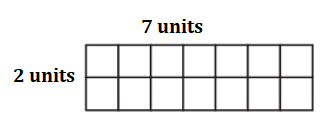
Area of the rectangle = 14 square units.
Explanation:
Length of the rectangle = 7 units.
Breadth of the rectangle = 2 units.
Area of the rectangle = Length of the rectangle × Breadth of the rectangle
= 7 × 2
= 14 square units.
b.

Area = ____________ square units
Answer:

Area of the rectangle = 40 square units.
Explanation:
Length of the rectangle = 8 units.
Breadth of the rectangle = 5 units.
Area of the rectangle = Length of the rectangle × Breadth of the rectangle
= 8 × 5
= 40 square units.
c.

Area = ____________ square units
Answer:
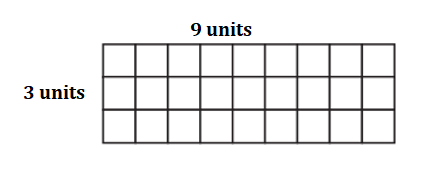
Area of the rectangle = 27 square units.
Explanation:
Length of the rectangle = 9 units.
Breadth of the rectangle = 3 units.
Area of the rectangle = Length of the rectangle × Breadth of the rectangle
= 9 × 3
= 27 square units.
Question 2.
Multiply.

Answer:
Multiplication equations:

Explanation:
Given multiplication equations:
3 × 4 = 12.
7 × 4 = 28.
4 × 5 = 20.
10 × 5 = 50.
9 × 5 = 45.
4 × 6 = 24.
9 × 9 = 81.
5 × 5 = 25.
7 × 7 = 49.
12 × 10 = 120.
8 × 2 = 16.
5 × 8 = 40.
11 × 9 = 99.
13 × 7 = 91.
10 × 15 = 150.
7 × 4 = 28.
Bridges in Mathematics Grade 3 Student Book Unit 5 Module 4 Session 4 Answer Key
Rainbow Rectangles
Question 1.
Work with the students in your group to put the rectangles in order, from least to most area.
Answer:
Rectangles in order, from least to most area:
Area of the rectangle = 14 square units.
Area of the rectangle = 27 square units.
Area of the rectangle = 40 square units.
Explanation:

Area of the rectangle = 14 square units.

Area of the rectangle = 40 square units.

Area of the rectangle = 27 square units.
Question 2.
After you’ve agreed on the order, write the colors of the rectangles where you think they belong in the boxes below.

Answer:

Explanation:

Area of the rectangle = 14 square units.

Area of the rectangle = 40 square units.

Area of the rectangle = 27 square units.
Question 3.
Estimate the area of each rectangle and then measure it in square inches. Remember to label your work with the correct units (square inches). Record your work on the chart below. (Hint: Use the red rectangle as a benchmark to help make your estimates.)
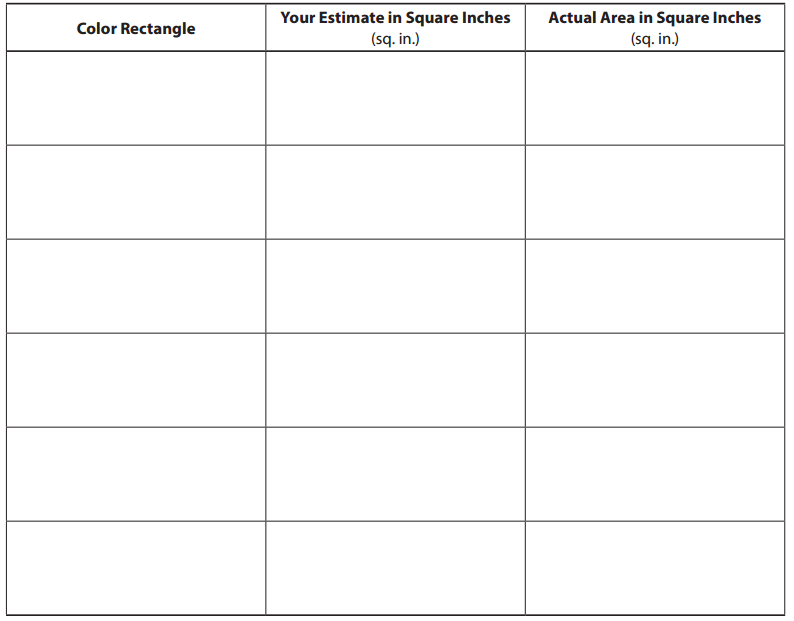
Answer:
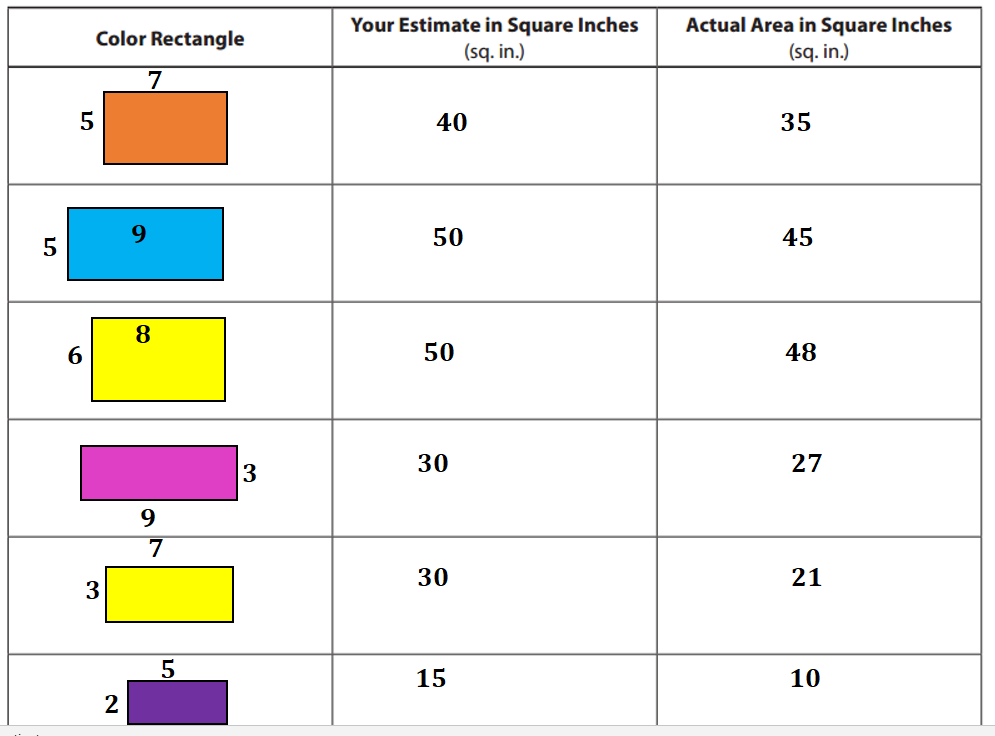
Explanation:
1. Rectangle: 7inches, 5 inches.
Estimation: 40 square inches.
Actual: 35 inches.
2. Rectangle: 9inches, 5 inches.
Estimation: 50 square inches.
Actual: 45 inches.
3. Rectangle: 8inches, 6 inches.
Estimation: 50 square inches.
Actual: 48 inches.
4. Rectangle: 9 inches, 3 inches.
Estimation: 30 square inches.
Actual: 27 inches.
5. Rectangle: 7 inches, 3 inches.
Estimation: 30 square inches.
Actual: 21 inches.
Rectangle: 5 inches, 2 inches.
Estimation: 15 square inches.
Actual: 10 inches.
Estimating & Measuring Area in Square Inches
Question 1.
James says all you have to do to find the area of a 4” × 5” rectangle is multiply 4 × 5 Do you agree? Why or why not?
Answer:
Yes, James is correct because area of rectangle is length × breadth same as multiply 4 × 5 or vise versa.
Explanation:
Length of the rectangle = 4 inches.
Breadth of the rectangle = 5 inches.
Area of the rectangle = Length of the rectangle × Breadth of the rectangle
= 4 × 5
= 20 square inches.
Question 2.
For each object on the chart below:
- Estimate the area of the first object on the chart below in square inches.
- Record your estimate in square inches.
- Find the area of the object using 1-inch tiles or a ruler, and record the measurement.
- Find the difference between your estimate and the actual measurement. Record the difference in the last column.
Hint: Use what you know about the area of the first object to estimate the others.


Answer:
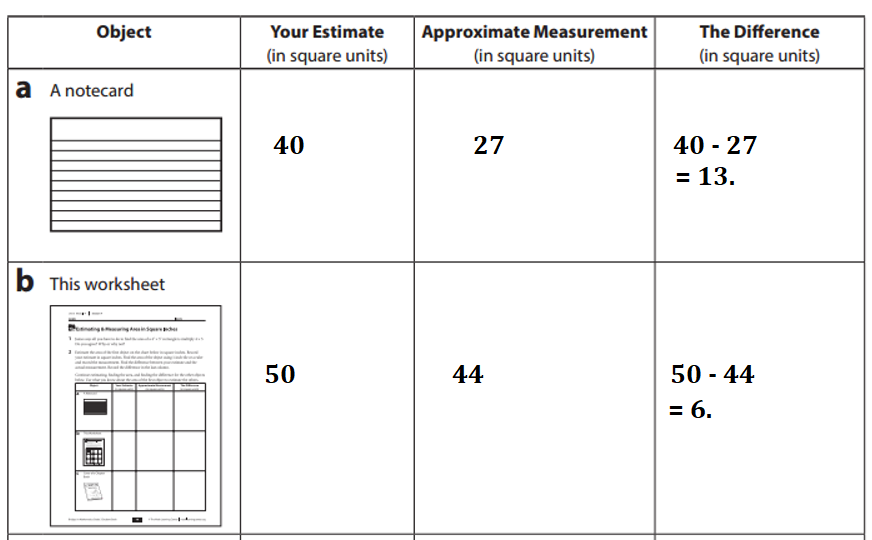

Explanation:
a. Area of the note card:
Estimation: 40 square units.
Actual: 9units,3 units
=> 27 square units.
Difference: 40 – 27 = 13 square units.
b. Area of a worksheet:
Estimation: 50 square units.
Actual: 11 units,4 units
=> 44 square units.
Difference: 50 – 44 = 6 square units.
c. Area of cover of a chapter book:
Estimation: 30 square units.
Actual: 6 units, 4units
=> 24 square units.
Difference: 30 – 24 = 6 square units.
Bridges in Mathematics Grade 3 Student Book Unit 5 Module 4 Session 5 Answer Key
Finding More Small Areas
The rectangles below have already been filled with square units. For each pair of rectangles:
- Label the dimensions of the first one.
- Multiply the dimensions to find the area. Write an equation to match.
- Break the second rectangle into two smaller ones. Find the area of each of the smaller rectangles and add them. Write equations to show your work.
ex:
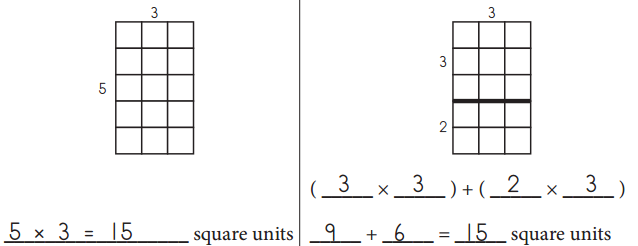
Question 1.

_____________ square units

(___________ × ____________) + (_____________ × ______________)
___________ + _____________ = _____________ square units
Answer:

Area of the square = 30 square units.
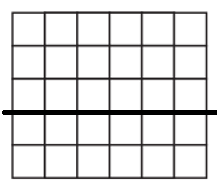
( 6× 3 ) + ( 6× 2 )
18+ 12 = 30 square units.
Explanation:
a. Number of rows = 6.
Number of columns = 5.
Total Area of the square = Number of rows × Number of columns
= 6 × 5
= 30 square units.
b. Number of rows = 6.
Number of columns = 3.
Area of the square 1 = Number of rows × Number of columns
= 6 × 3
= 18 square units.
Number of rows = 6.
Number of columns = 2.
Area of the square 2 = Number of rows × Number of columns
= 6 × 2
= 12 square units.
=> Total Area of the square = Area of the square 1 + Area of the square 2
= 18+ 12
= 30 square units.
Question 2.
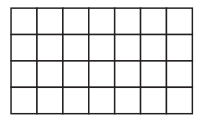
_____________ square units

(___________ × ____________) + (_____________ × ______________)
___________ + _____________ = _____________ square units
Answer:

Area of the square = 28 square units.
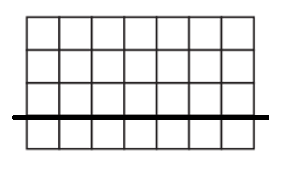
( 7 × 3 ) + ( 7 × 1 )
21 + 7 = 28 square units.
Explanation:
a. Number of rows = 7.
Number of columns = 4.
Total Area of the square = Number of rows × Number of columns
= 7 × 4
= 28 square units.
b. Number of rows = 7.
Number of columns = 3.
Area of the square 1 = Number of rows × Number of columns
= 7 × 3
= 21 square units.
Number of rows = 7.
Number of columns = 1.
Area of the square 2 = Number of rows × Number of columns
= 7 × 1
= 7 square units.
=> Total Area of the square = Area of the square 1 + Area of the square 2
= 21+ 7
= 28 square units.
Bridges in Mathematics Grade 3 Student Book Unit 5 Module 4 Session 6 Answer Key
Fractions Revisited
Question 1.
Fill in the bubble next to the fraction that shows how much of each shape is filled in.
ex:
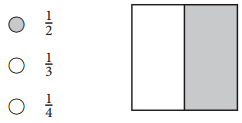
a.
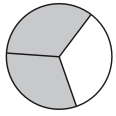
![]() \(\frac{1}{2}\)
\(\frac{1}{2}\)
![]() \(\frac{1}{3}\)
\(\frac{1}{3}\)
![]() \(\frac{2}{3}\)
\(\frac{2}{3}\)
Answer:

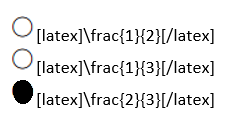
Explanation:
Number of Shaded parts = 2.
Total number of parts = 3.
Portion of shaded part = Number of Shaded parts ÷ Total number of parts
= 2 ÷ 3 or \(\frac{2}{3}\).
b.
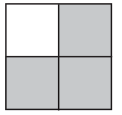
![]() \(\frac{1}{2}\)
\(\frac{1}{2}\)
![]() \(\frac{3}{4}\)
\(\frac{3}{4}\)
![]() \(\frac{4}{3}\)
\(\frac{4}{3}\)
Answer:

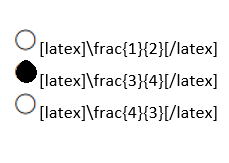
Explanation:
Number of Shaded parts in the square = 3.
Total number of parts in the square = 4.
Portion of shaded part in the square = Number of Shaded parts in the square ÷ Total number of parts in the square
= 3 ÷ 4 or \(\frac{3}{4}\).
c.
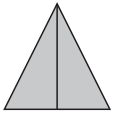
![]() \(\frac{2}{1}\)
\(\frac{2}{1}\)
![]() \(\frac{1}{2}\)
\(\frac{1}{2}\)
![]() \(\frac{2}{2}\)
\(\frac{2}{2}\)
Answer:

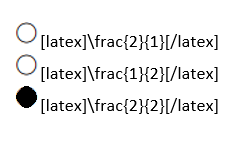
Explanation:
Number of Shaded parts in the triangle = 2.
Total number of parts in the triangle = 2.
Portion of shaded part in the triangle = Number of Shaded parts in the triangle ÷ Total number of parts in the triangle
= 2 ÷ 2 or \(\frac{2}{2}\).
d.

![]() \(\frac{2}{4}\)
\(\frac{2}{4}\)
![]() \(\frac{2}{3}\)
\(\frac{2}{3}\)
![]() \(\frac{2}{2}\)
\(\frac{2}{2}\)
Answer:

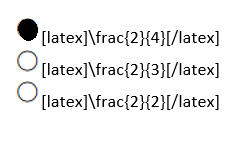
Explanation:
Number of Shaded parts in the circle = 2.
Total number of parts in the circle = 4.
Portion of shaded part in the circle = Number of Shaded parts in the circle ÷ Total number of parts in the circle
= 2 ÷ 4 or \(\frac{2}{4}\).
e.
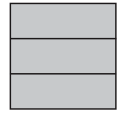
![]() \(\frac{1}{3}\)
\(\frac{1}{3}\)
![]() \(\frac{2}{3}\)
\(\frac{2}{3}\)
![]() \(\frac{3}{3}\)
\(\frac{3}{3}\)
Answer:

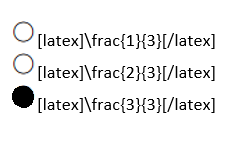
Explanation:
Number of Shaded parts in the rectangle = 3.
Total number of parts in the rectangle = 3.
Portion of shaded part in the rectangle = Number of Shaded parts in the rectangle ÷ Total number of parts in the rectangle
= 3 ÷ 3 or \(\frac{3}{3}\).
Question 2.
Follow the instructions to color the array below.
- Color half the squares in the array red.
- Color one-fourth of the squares in the array blue.
- Color the rest of the squares in the array green.

What fraction of the array is green?
Answer:
Fraction of the array is green = 20 ÷ 4 or \(\frac{20}{4}\)
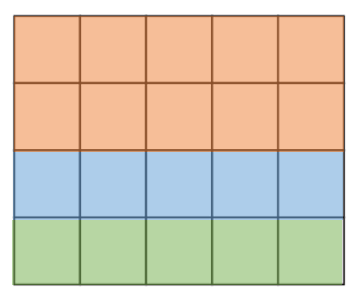
Explanation:
=> Total number of squares = 5 rows × 4 column
=> 20 squares.
Color half the squares in the array red.
=> 20 ÷ 2 or \(\frac{20}{2}\) = 10 squares.
Color one-fourth of the squares in the array blue.
=> 20 ÷ 4 or \(\frac{20}{4}\) = 5 squares.
Color the rest of the squares in the array green.
=> Green squares = Total squares – (Red squares + Blue squares)
=> Green squares = 20 – (10 – 5)
=> Green squares = 20 – 15
=> Green squares = 5 squares.